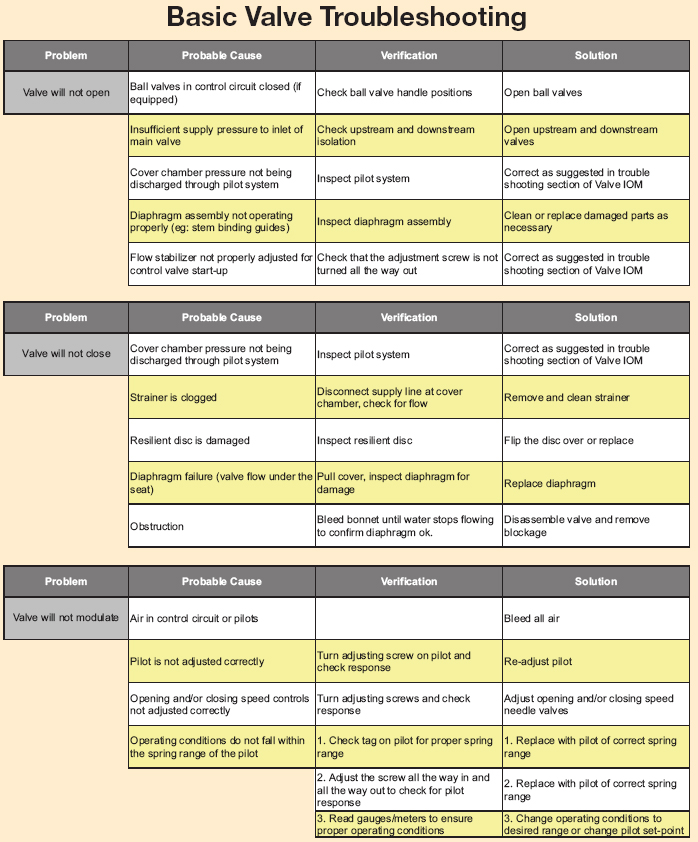A simple maintenance routine can help ensure trouble-free valve operation.
Whether the control valve in your system is the first one that has required maintenance or if you are experienced with maintaining multiple valves in your system, some simple guidelines can help keep them operating at optimal performance.
Physically checking all valves at least every 12 weeks is important, assuming that everything is running fine in the system. This inspection is to look for any leaks in the tubing. The pressure gauges should be checked to ensure that the valve is performing as designed. The inspection should make sure that nothing looks abnormal.
If something is wrong, always ensure that the correct instruction manual for the valve is on hand. Today, many manufacturers have these available on their websites. As a note of caution, valves are under pressure and care should be taken to bleed pressure off the valve before taking any valve apart. (For example, in a 6-inch valve with 100 psi in the line, at least 2,800 pounds of force is trying to push the cover off the valve, so safety first.) Regular maintenance will ensure that valves remain healthy.
Basic Valve Troubleshooting

Pilot System Shut-Off Ball Valves
Exercise the three isolating cocks on the main valve. These are located in front of the strainer on the upstream side of the valve, on the valve bonnet on top of the valve and below the pressure-reducing pilot on the valve downstream. Giving the isolating cock a momentary quarter turn to the closed position, then returning it to open is sufficient. Open position is when the handle of the isolating cock is in-line with its body.
Air in the Pilot System
Air is the primary enemy in the pilot system because it will give false readings and cause poor valve operation. Bleed air from the valve bonnet. If the valve is equipped with a position indicator, on top of the position indicator is a bleed cock. Open the bleed cock slightly by turning the handle counter-clockwise.
Otherwise, bleed the air from the high point of the valve. If the water runs clear and no air bubbles are seen in the glass of the position indicator, close the bleed cock. If air is present (the water will be foamy white) run the water until the air is gone.
Strainers
Pilot systems rely on a supply of clean water, usually taken from the inlet of the valve. Either external or flush clean strainers can be installed. If an external strainer is installed, a simple occasional flush is a good idea. Normally, three to five seconds is sufficient to clean the strainer screen.
Experience will dictate if it needs to be flushed longer than this. A number of water utilities install a ball valve on the flushing plug of the strainer, allowing operators to give a short flush every time they are in the valve station. A plugged strainer can cause a valve to remain and result in major problems.
Reducing Pilot
Ensuring that the control valve pilot is operational is a simple task. As a cautionary note—before making any pressure adjustment—ensure that this is acceptable for the system and that any SCADA alarm controls that may be triggered are turned off. To exercise the pressure-reducing pilot, loosen the lock nut on the pilot adjusting screw and turn clockwise to increase the pressure 5 psi above the normal set point.
Check that the downstream pressure gauge is tracking the adjustments made. Then turn the adjusting screw counter-clockwise to reduce the pressure to 5 psi below the set point.
Finally, turn the adjusting screw clockwise to increase the pressure back to the original set point, and tighten the lock nut. If the pressure gauge does not move as you adjust the screw, either the gauge is bad or a pilot should be examined.
Main Valve Flows
Just as we all like to take our cars out for an occasional run to give them a good workout, valves also need to see some decent flow occasionally. During a major fire is not a good time to find out that the main valve will not open fully. First, get some flow through the valve station to open the peak demand/fire-flow valve. (This could be as simple as opening a hydrant on the outside of the valve station).
If a station or vault has two valves in parallel, with one valve handling normal flow and the other handling large or fire flows, the larger valve should be operated for a minimum of five minutes. This can be done by closing the isolating cock on the downstream side of the smaller valve pilot system (the cock below the pressure-reducing pilot). This will close the smaller valve and cause the larger valve to open and allow flow into the system. The above four steps can be followed for the larger valve while it is in flowing mode.
This is also a good time to ensure that the main line control isolating valves are in good working order. The gate or butterfly valves used to isolate the control valve should also be checked, in case they are needed. Following this routine can help provide years of trouble-free service.
Pumps & Systems, July 2011

